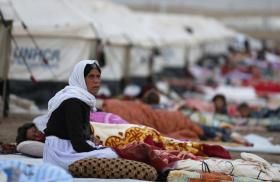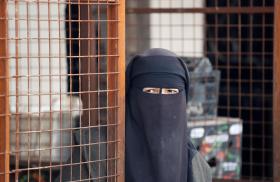
- Policy Analysis
- PolicyWatch 3094
The Battle Against Extremism: Assessment and Prescriptions

Part of a series: Counterterrorism Lecture Series
or see Part 1: U.S. Efforts against Terrorism Financing: A View from the Private Sector
Three experts on countering violent extremism discuss a new book and offer ideas for how government, civil society, business, and citizens can act on this persistent policy challenge.
On March 19, Farah Pandith, Juan Zarate, and Matthew Levitt addressed a Policy Forum at The Washington Institute. Pandith is a senior fellow with the Future of Diplomacy Project at the Harvard Kennedy School’s Belfer Center for Science and International Affairs, and author of How We Win: How Cutting-Edge Entrepreneurs, Political Visionaries, Enlightened Business Leaders, and Social Media Mavens Can Defeat the Extremist Threat. Zarate is a senior advisor at the Center for Strategic and International Studies and author of Treasury’s War: The Unleashing of a New Era of Financial Warfare. Levitt is the Fromer-Wexler Fellow at the Institute and director of its Reinhard Program on Counterterrorism and Intelligence.
Farah Pandith
Since the September 11, 2001, attacks, fierce attention has been paid to what it means to be Muslim—and young Muslims have grown up seeing the word Islam constantly in the headlines. This attention can obviously have good and bad influences, but terrorist organizations that hope to recruit people as part of their armies have been tailoring their messages to exploit the resulting confusion young Muslims feel about their identity. Western and other officials understand this, too. They understood that, because of the Internet, what happened almost fifteen years ago during the cartoon crisis in Copenhagen also affected young people in Kabul. Through the help of embassies and special envoys to Muslim communities, the U.S. government could grasp the concerns and general mindset of people growing up after 9/11 in these communities. That demographic is the focus of my new book, How We Win.
Identity and belonging were the central component, or data point, connecting the experience of young Muslims around the world in the post-9/11 era. The questions Muslim millennials asked in non-Muslim-majority countries like Spain or Italy were the same ones their peers were asking in Morocco or Malaysia. This was striking. Yet the U.S. government had trouble identifying this connection because it tends to compartmentalize its focus by region. Ideological war, however, does not limit itself to a specific region or country.
For instance, a parent in Denmark asked, with tears in his eyes, how he could be raising his child in a place where he was surrounded by so few diverse Muslim voices. A group of Zanzibari students explained that the authentic African Islam infused with Arab elements particular to Zanzibar was changing due to foreign influences. American Muslims talked of feeling as if they did not belong in their own country. All these conversations reflected the emotional aspects of a markedly ideological war.
Government, however, doesn’t do emotion well. For that reason, it cannot work alone. It can, however, partner with companies and NGOs to address the issues raised here. Today, NGOs are employing innovative and proven solutions, and they need government funds to reach appropriate scale. The most important role served by government should be that of convener, intellectual partner, and facilitator. The U.S. Congress needs to understand that the soft-power war has not received money equivalent to the hard-power war, and that this balance needs to be rectified in order to stop terrorist recruitment. Similarly, the private sector must be willing to work with the government. The kind of thinking and cultural listening that companies around the world already do can be channeled and used by the NGOs on the ground.
During the Bush and Obama administrations, officials learned that the front end of countering violent extremism must come through locals and credible voices on the ground—primarily NGOs—because simply holding up the American flag and making a plea does not move a young person in a new direction. But local NGOs are often desperately underfunded, which should not be the case. Both the government and private corporations should be giving these NGOs the funding they need to do the work they already know how to do.
The question often arises of how government should organize itself to combat the ideology of violent extremism. In truth, it doesn’t matter what department dedicates itself to the issue, only that someone thinks about it every day—just as many individuals are daily dedicated to military and intelligence issues. More important still, the work must be collaborative and integrated, with everyone in every sector, whether private or public, contributing to the range of solutions.
Juan Zarate
Practitioners of countering violent extremist (CVE) are at a watershed for dealing with the question both domestically and within the international community. The moment requires deep reflection. Although the American public tends to look at issues in waves, paying attention to some while temporarily ignoring others, Farah’s book demonstrates that violent extremism is an issue central to national security that requires continuous attention. It cannot be allowed to drift from the public eye.
During the early years of the Bush administration, practitioners faced a number of challenges. One, for example, was how to talk about the battle of ideas and capture the long-term dimensions of ideological struggle without alienating communities with which they needed to partner, especially Muslim communities around the world. CVE professionals resolved to think broadly in terms of extremist ecosystems where particular groups such as al-Qaeda, the Islamic State, and far-right groups were active.
Farah’s book highlights five lessons that are still important today. The first is that CVE is an issue of identity. That was a key revelation for many in the U.S. government: that the challenge wasn’t simply a matter of one group or one terrorist manifestation, but about how communities viewed themselves and others. The second is that this struggle against extremism is generational, rather than episodic. It is driven by how millennials see themselves and the world around them. Third is that the ecosystem of extremism is not bound by traditional ideological lines, explaining why far-right extremism merits attention as part of this ecosystem. Fourth is that CVE cannot be viewed as merely an ancillary or interesting part of counterterrorism, because the inherent issues are much broader and deeper, underpinned by communities’ self-perceptions. These issues require a different way of enlisting communities in combating them. The fifth lesson is the idea, deeply embedded in Farah’s work, of empowering open societies to combat violent extremism. Here, the government serves not as the protagonist but as the enabler. Related is the need to find credible voices that can shape the environment proactively, along with relying on the technology community to lead the way in preventing violent extremism. This community must do so not just reactively by removing content, but proactively—by promoting networks that are trying to counter extremism.
Matthew Levitt
Today’s conversation about Farah’s book is particularly timely. In the Trump administration’s new counterterrorism strategy, its main theme—whether you call it countering violent extremism, counterradicalization, preventing violent extremism, or terrorism prevention—plays a prominent role, and the interagency is now sitting down to try to implement this focus.
This book gives voice to the search for cultural identity. While this may seem like an obvious issue to discuss—and one that has been written about many times before—Farah’s book talks about it in a unique way that’s invaluable to practitioners. The critical piece of the search for a cultural identity is a search for authenticity, and who presents authenticity. Because of Farah’s positions in government, this book primarily focuses on these issues in the world’s Muslim communities. But these conversations about identity and authenticity are just as applicable anywhere else, as people are looking for a cultural identity, feeling that their identity is being challenged, or just looking for something authentic.
For example, analysts have long pointed to the American melting pot and how well immigrants integrate into American society as one reason that radicalization to ideologically driven violence has not been as high here as, for example, in Europe. But youth in the United States experience the same issues tied to identity and the search for authenticity as others, especially in the information and social media age. That suggests that radicalization trends in the United States could move in a difficult direction, integration success notwithstanding.
To get ahead of the curve, U.S. officials must incorporate preexisting programs and pools of money from violence prevention, public safety, and public health efforts into those aimed at preventing violent extremism. They must focus on harnessing the resources of public health, in particular, with its tiers of focus on global, community-level, and individual perspectives. And they need to support programs that engage with the individual—something the Islamic State and other adversaries have done more effectively by comparison—and not only try to solve problems on the community level.
Prevention is where the government gets the biggest bang for its buck. Because the Department of Justice has funded metrics and evaluations for programs to counter violent extremism, the excuse that these programs are not guaranteed to work is beginning to wear thin. Therefore, funding these programs is vital, as is learning from programs in Canada, Australia, and various European countries.
This summary was prepared by Avi Bass.
The Policy Forum series is made possible through the generosity of the Florence and Robert Kaufman Family.






